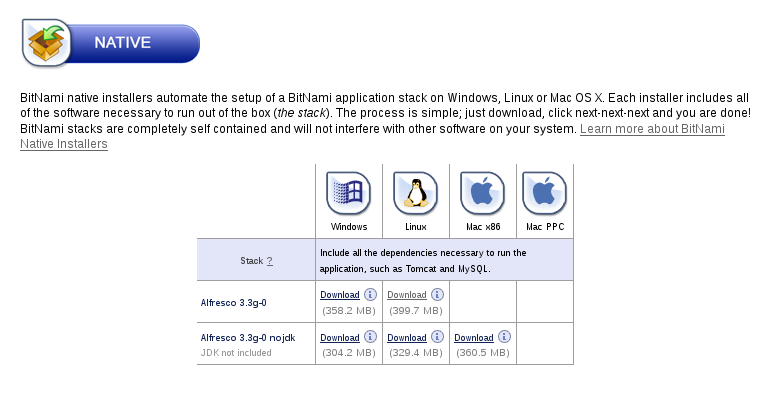

#About bitnami alfresco community stack mac os
You have several options - a “native” installer for Windows, Linux, or Mac OS X, which will whip Alfresco onto a server or onto a desktop without touching other system software. In this case, they configure MySQL, Java, Tomcat, and so forth.
#About bitnami alfresco community stack full
BitNami produces “stacks” of software that include the full gamut of software needed to run a complex application like Alfresco. If you’re looking to get started with Alfresco without any startup costs or fiddling with installation, I’d recommend starting with the BitNami Stack.

For the purposes of this column, I’m assuming you’re going with the Community Edition. If you’re running a small business with fewer than 50 or 100 seats, you probably don’t. If you’re running a larger company, you may need those things. It also has features to help set up clustering, enterprise extensions, and (of course) support and Service Level Agreements (SLAs) that you should expect to pay for. Specifically, the Enterprise version has support for SQL Server and Oracle, and for the BEA WebLogic and Websphere app servers. The company offers an Enterprise release that is not entirely open source, but it does offer a lot of features you don’t have in the open source release. In addition, Alfresco’s Community Edition is open source - so there’s no cost to start working with it and testing it out.

For many businesses, Alfresco functions as an alternative to Microsoft Sharepoint. You might think of a simple publishing platform when you think CMS, but Alfresco is a bit more than that - it supports document sharing, storage, workflows, collaboration, and it serves as a publishing platform. Understanding AlfrescoĪlfresco is an open source content management system (CMS) or enterprise content management system according to the marketing materials. Using Alfresco or another content management system - in addition to concrete and very firm policies about using said software - helps mitigate that problem by ensuring that information is stored in an accessible repository where the employees within the appropriate groups can get to it. When an employee gets promoted, fired, or otherwise moves on, this makes it doubly difficult to extract information. Second, each employee in a small business is usually responsible for a variety of disparate tasks, and they end up carrying vital information in their heads or buried in their email.

Defining the “ who-doesn’t” part is sometimes just as important as who does. It also lets managers sidestep some collaboration problems by defining a workflow that highlights who needs to provide input and who doesn’t. Any Word/Office document that needs editing by two or more people means a slew of emails - and usually requires prodding of that one person who loses the thread.Ī good content management system with a workflow solves that problem by ensuring that each person knows what’s expected and when they need to give input. First, consider collaborating on something relatively simple like a presentation or proposal for a customer. I’ve worked for quite a few startups and small businesses, and the amount of data that ends up trapped in email is astounding. Why does a small business need collaboration, content management, and document sharing in the first place? If you do any kind of knowledge work, even in a smallish business, you’re probably producing quite a bit of information. The Benefits of Content Managementīefore we get into what Alfresco does, let’s back up a moment. If you’re running a small or medium-sized business, you might want to consider setting up the Alfresco open source content management system to boost document sharing, collaboration, and more. Having the right collaboration tools is a key to success, even in a small business.


 0 kommentar(er)
0 kommentar(er)
